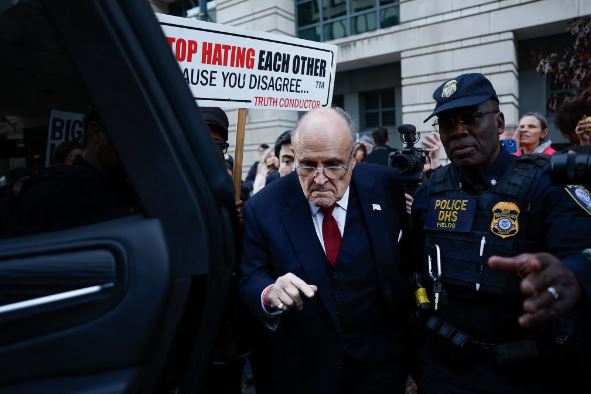In a dramatic turn of events, Rudolph W. Giuliani, former mayor of New York and legal luminary, filed for bankruptcy just a day after a federal judge demanded he start paying the staggering $148 million in damages owed to two former Georgia election workers. The damages stem from baseless claims Giuliani made, accusing the workers of attempting to steal the 2020 election from Donald J. Trump.
Giuliani’s financial troubles extend beyond the damages he owes, encompassing millions in unpaid legal fees and pending state and federal income taxes. The bankruptcy filing also reveals a looming $152.7 million owed to various creditors and potential damages from pending lawsuits.
Last week, a jury ruled in favor of the two former Georgia election workers, Ruby Freeman and Shaye Moss, ordering Giuliani to pay $148 million for false accusations of cheating during the vote counting in Fulton County, Ga., on November 3, 2020. Concerned that Giuliani might attempt to conceal his assets, Judge Beryl A. Howell ordered immediate payments, prompting Giuliani’s swift bankruptcy filing.
Giuliani’s political adviser, Ted Goodman, acknowledged that the filing should not come as a surprise, given the astronomical punitive amount his client was ordered to pay. The Chapter 11 bankruptcy protection sought by Giuliani allows him the time and opportunity to pursue an appeal while ensuring transparency in managing his finances under the supervision of the bankruptcy court.
In the filing, Giuliani revealed a total debt of $152.7 million, including unpaid taxes. Back federal taxes exceeded $700,000, with nearly $300,000 owed in delinquent state taxes. Additionally, he owes approximately $1.3 million to a law firm that represented him in criminal investigations and $387,000 to a firm guiding him through disbarment proceedings related to his efforts to influence election outcomes.
This bankruptcy filing adds to Giuliani’s legal woes since he took on the role of lead lawyer in Donald Trump’s attempts to overturn the 2020 election results. Apart from the damages owed to Freeman and Moss, Giuliani faces a lawsuit from Dominion Voting Systems and has been indicted in Georgia on racketeering charges related to election tampering.
The bankruptcy filing also mentions Giuliani’s involvement in suits brought by Hunter Biden and Smartmatic, a voting technology company entangled in conspiracy theories surrounding Trump’s election loss. This filing offers a clearer look at Giuliani’s often opaque financial troubles.
Bankruptcy, however, will not shield Giuliani from paying damages to Freeman and Moss, as these damages are considered an “intentional tort.” This move comes on the heels of the Internal Revenue Service (IRS) placing a lien on Giuliani’s Palm Beach property for failing to pay over $500,000 in income taxes. Giuliani is also attempting to sell his Upper East Side apartment in New York for $6.1 million.
Once a high-earning private lawyer, Giuliani’s finances have witnessed a downturn, exacerbated by his divorce from his third wife, exposing extravagant spending habits, multiple houses, and numerous country club memberships. As of early 2019, Giuliani’s financial documents revealed a dwindling cash reserve and increasing credit card debt.
The federal trial that led to the damages owed to Freeman and Moss underscored the severity of the financial burden Giuliani faces. His lawyer, Joseph Sibley IV, likened even a $43 million penalty to the civil equivalent of the death penalty.
Rudy Giuliani’s bankruptcy filing marks a significant chapter in his tumultuous post-legal career. The filing illuminates the extent of his financial challenges, stemming from legal battles, unpaid taxes, and a high-profile divorce. As Giuliani navigates this financial storm, the ongoing lawsuits and damages owed serve as a stark reminder of the consequences of his actions in the post-2020 election legal landscape.

